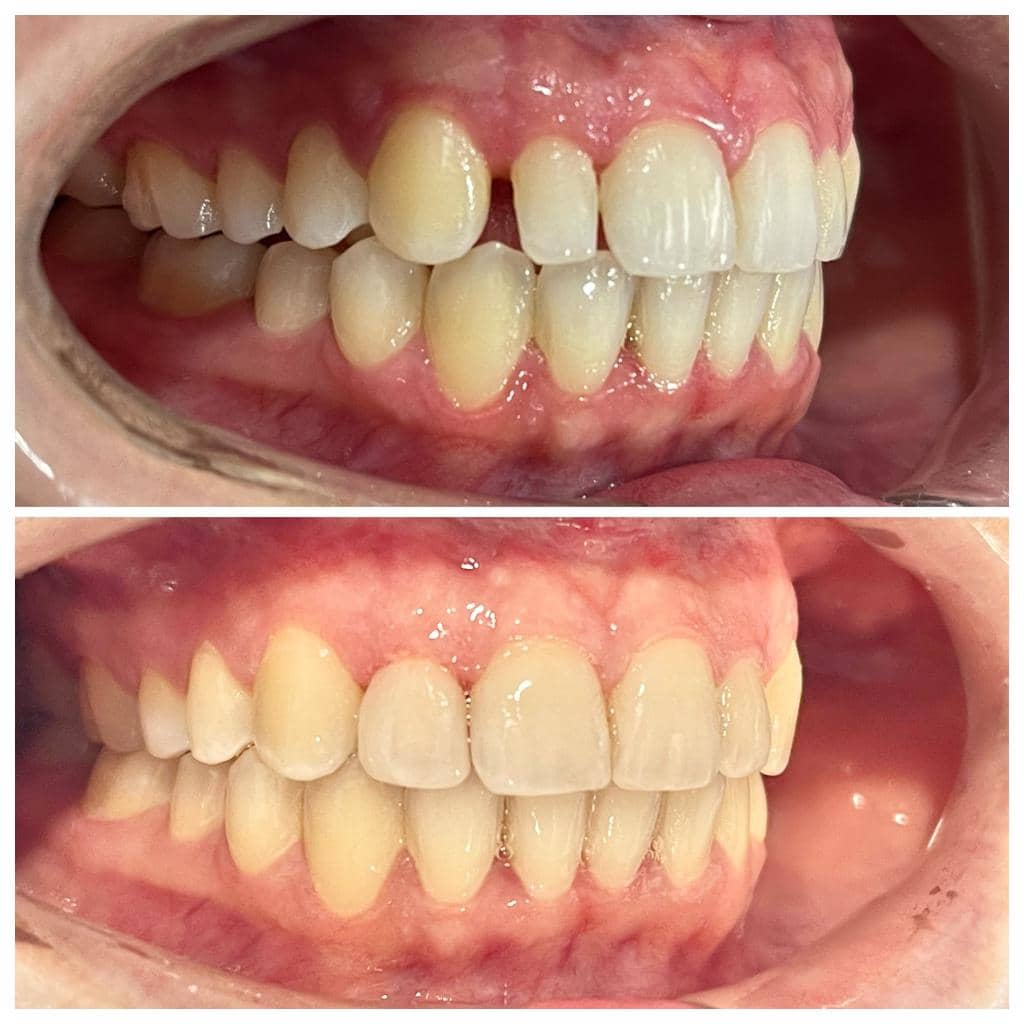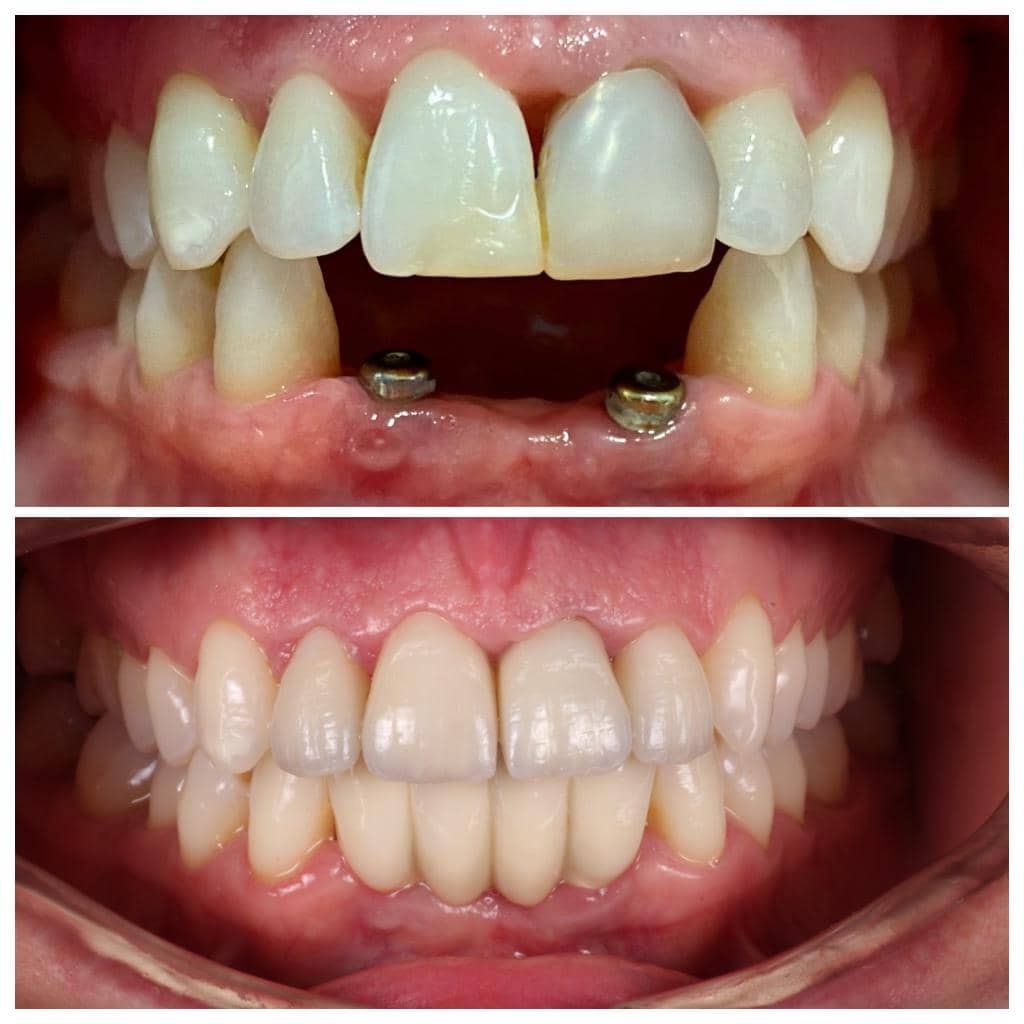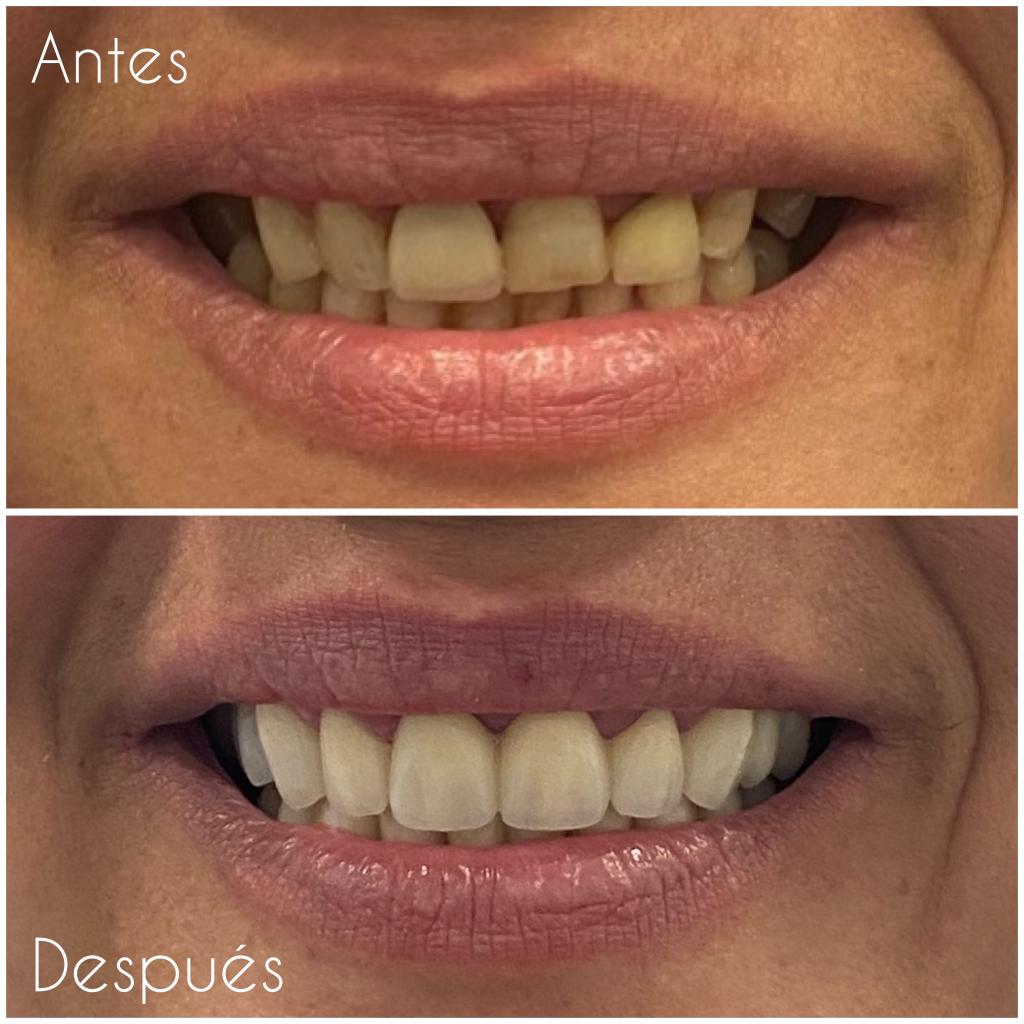Dental Aesthetics in Tenerife

What is cosmetic dentistry and what can you expect from our cosmetic dentistry treatments in Tenerife?
Some of the most common cosmetic dental treatments include teeth whitening, dental veneers, dental crowns, and filling gaps between teeth. Teeth whitening is used to remove stains and discoloration from the teeth, while dental veneers are thin layers placed over the surface of the teeth to enhance their appearance.
Dental crowns, on the other hand, are caps that cover the entire tooth and are used to restore the shape, size, and strength of damaged teeth. Finally, filling gaps between the teeth is used to correct the appearance of crooked or spaced teeth.
Cosmetic dentistry treatment is applied to improve the appearance of the smile and address various issues such as dental asymmetry, gaps between the front teeth, discoloration, cavities near the gum line, or dental fractures.
It is important to note that cosmetic dental treatments not only improve the appearance of the teeth but can also have functional benefits. For example, teeth whitening can improve oral health and prevent cavities, while dental veneers can protect teeth and prevent future damage.
It is essential to consult a qualified professional before undergoing any cosmetic dental treatment to ensure that the treatment is appropriate and safe for the patient.
For example, if the patient has active periodontal disease, untreated decay, fractured or injured teeth, and severe bite problems, these should be treated before considering any cosmetic dentistry treatment.
It is also important to consider any allergies or sensitivities to dental materials used in treatment.
In general, it is recommended that patients undergo a full oral health assessment before considering any cosmetic dentistry treatment.


Crowns can be made of different materials, such as porcelain, ceramic, metal or a combination of these.
The fitting of a dental crown usually requires several visits to the dentist.
During the first visit, the dentist will prepare the tooth for the crown, which involves grinding and shaping the tooth so that the crown can fit perfectly. An impression of the tooth will then be taken so that a customised crown can be created in the dental laboratory.
At the last visit, the dentist will permanently place the crown on the prepared tooth. Prior to placement, the crown will be checked for fit and aesthetics and, if necessary, adjustments will be made. Once properly fitted, it will be permanently bonded to the tooth with dental cement.
Dental crowns can be recommended for a variety of dental problems, such as deep cavities, fractures, discoloured or misshapen teeth, and to cover a dental implant. It is important to maintain good oral hygiene and have regular check-ups with your dentist to prolong the life of the crown and avoid additional dental problems.
Information about Dental Aesthetics treatments
Recover your smile in our dental clinic
Dental prosthesis in Tenerife: advanced solutions for stable and natural rehabilitation
Dental prosthesis in Tenerife on implants for a firm and functional smile In dental prosthesis in Tenerife, implant-supported rehabilitation begins with a detailed diagnostic assessment that allows the team to evaluate functional and aesthetic needs. At SJD Dentistas, this process is based on a precise clinical analysis that determines available…
Dental implants in Tenerife: the most reliable option to restore function, aesthetics and oral health
Dental implants in Tenerife: beyond aesthetics At SJD Dentistas, every treatment begins with a thorough evaluation of the patient’s oral condition, assessing bone structure, functional needs and aesthetic expectations. Choosing dental implants in Tenerife allows patients to regain comfort when chewing, speak naturally and maintain a fully integrated appearance. The…
Dental clinic in Tenerife: personalised care and advanced treatments
Finding the right dental clinic in Tenerife can make a big difference in maintaining a healthy and confident smile. At SJD Dentistas, we combine experience, technology, and personalised attention to deliver dental care that truly meets the needs of each patient. Our mission is to improve oral health through prevention,…
Brighten your smile with professional tooth whitening in Tenerife
A bright, white smile can make a powerful impression, boosting your confidence and enhancing your overall appearance. At SJD Dentists, we specialise in tooth whitening in Tenerife, offering advanced treatments that effectively remove stains and restore the natural brightness of your teeth. Our clinics in La Laguna and Las Chafiras…
Comprehensive endodontic treatment at SJD Dentists: specialists in endodontics Tenerife
When it comes to saving a natural tooth that has been damaged or infected, endodontics plays a vital role. At SJD Dentists, we are proud to be a benchmark in endodontics Tenerife, offering high-quality treatments with advanced technology and a team of specialists dedicated to excellence. Our goal is to…
Dental clinic in Tenerife: comprehensive care for your smile
Maintaining a healthy mouth is much more than just a cosmetic issue: it is an investment in your overall well-being. If you are looking for a dental clinic in Tenerife that offers quality care, cutting-edge technology, and a team of friendly professionals, it is important to know which services can…
CUSTOMER REVIEWS SJD DENTISTS

Todo el personal con una estupenda actitud de trato. Yo me suelo poner muy nervioso en estos casos, pero de verdad que que me han transmitido calma y serenidad.
Clínica en muy buenas condiciones.
Gracias
Por otro lado el funcionamiento de la clínica es inmejorable, rara vez he tenido que esperar más de 10 minutos, siempre te pueden adaptar la cita a tus horarios. Muchas gracias por todo
Gracias 🤩
Han salido contentísimos, muchísimas gracias.
Todo lo que diga es poco para el trato que recibo
Hoy fue un día especial para mí y mis miedos,ellos hacen que me sienta bien y me trasmiten muchísima tranquilidad,son unos profesionales que te hacen sentir como en casa,pero además devolviendote la sonrisa
Prueba superada🥰👌
GRACIAS 🫂
Saludos
Juan Manuel Mesa.

Gracias por todo y por esta ayuda tan grande que hace recuperar la sonrisa.
Absolutamente recomendable.
Frequently asked questions about dental aesthetics.
In this section we will answer the most important frequently asked questions that most clients have about cosmetic dentistry.
What options are available to improve the aesthetics of my smile?
There are several options to improve the aesthetics of the smile, among them:
Tooth whitening: this is a treatment that is carried out to achieve a lighter shade of teeth. .
Dental veneers: these are thin sheets of porcelain or resin that are placed on the surface of the teeth to correct problems of shape, size or colour.
Dental crowns are prostheses that are placed over damaged or heavily restored teeth to improve their appearance and function.
Dental implants are artificial roots that are placed in the bone to replace missing teeth, improving the appearance and function of the smile.
Orthodontics: is a treatment to correct the position of the teeth and achieve a correct function and aesthetics of the mouth.
It is important to consult a professional to determine which of these options is the most suitable for each specific case.
What is a dental veneer and how can it improve the appearance of my teeth?
Dental veneers are thin shells of porcelain or resin that are bonded to the front surface of teeth in order to improve their aesthetic appearance. These veneers are customised for each patient, and are designed to cover dental imperfections such as stains, discolouration, fractures, wear or gaps between teeth.
The placement of dental veneers is a minimally invasive process that can be performed in one or several procedures, depending on the complexity of the case. First, a thorough dental evaluation is performed to determine if the patient is a good candidate for dental veneers. Then, a dental mould is made to custom design the veneers.
At the time of placement, the dentist will clean and prepare the surface of the teeth so that the veneers will adhere properly. Next, a special adhesive will be applied to bond the veneers to the surface of the teeth, and a special light will be used to harden the adhesive. Finally, the veneers will be adjusted and polished to fit the teeth perfectly.
Dental veneers are an excellent option to improve dental aesthetics, but it is important to bear in mind that their duration will depend on the care given to them, as well as the patient's dental health. It is advisable to have regular check-ups with your dentist to ensure that dental veneers are properly maintained.
Is the teeth whitening process painful?
In very rare cases, some people may experience increased tooth sensitivity that may require discontinuation of treatment or the use of alternative techniques.
It is important to follow the instructions of the dentist or dental aesthetician to minimise any possible discomfort or pain.
How many types of teeth whitening are there?
There are different types of teeth whitening, among which are the following:
In-office teeth whitening: This type of whitening is performed in the dental clinic and is carried out using a special light and a hydrogen peroxide gel.
Teeth whitening with splints: This type of whitening is carried out at home, using splints that are placed on the teeth and contain a whitening gel. The treatment lasts several weeks and the splints must be worn for several hours a day.
Mixed teeth whitening: This type of whitening combines in-office teeth whitening with teeth whitening with splints. The treatment starts with a session in the dental clinic and then continues at home with the splints.
Each type of tooth whitening has its advantages and disadvantages, and the dentist will be best able to advise the patient on which is the most suitable in their particular case.
How can I keep my teeth white after teeth whitening treatment?
After undergoing a teeth whitening treatment, there are some tips you can follow to keep your teeth white for longer, such as:
Avoid foods and drinks that stain teeth, such as coffee, tea, red wine, chocolate, fizzy drinks and foods with artificial colours.
Brush teeth after every meal, and especially after consuming foods or drinks that stain teeth.
Use dental floss and mouthwash to remove food debris and plaque from hard-to-reach places.
Avoid tobacco and tobacco-containing products, which can stain teeth and reduce the effectiveness of tooth whitening treatment.
Visit your dentist regularly for dental cleanings and assessments of your overall dental health.
By following these tips, you can prolong the effects of teeth whitening and maintain a brighter, healthier smile.
What is invisible orthodontics and how does it work?
Invisible orthodontics is an orthodontic treatment that uses clear, removable aligners to correct the position of teeth. Instead of traditional brackets and wires, invisible orthodontics uses a series of aligners custom-made for each patient.
Each aligner is worn for about a week and then exchanged for the next in the series, allowing the teeth to gradually move into the desired position. The aligners are virtually invisible and can be removed for eating and brushing, making them more comfortable and convenient than brackets and wires.
Invisible orthodontic treatment begins with careful evaluation and planning by a trained orthodontist. The orthodontist will use images and models of the patient's teeth to create a personalised treatment plan and determine the number of aligners needed.
As the patient progresses through treatment, the orthodontist will perform regular check-ups to make sure the teeth are moving correctly and make adjustments as needed. Invisible orthodontic treatment can last from a few months to several years, depending on the complexity of the case and the length of treatment recommended by the orthodontist.
What is the difference between traditional orthodontics and invisible orthodontics?
The main difference between traditional orthodontics and invisible orthodontics is the way teeth are moved into their correct position.
Traditional orthodontics uses brackets and wires to apply direct force to the teeth and gradually move them into their desired position.
Invisible orthodontics, on the other hand, uses customised clear braces (such as Invisalign) that apply gradual force to the teeth to move them into their desired position.
In addition, invisible braces are less visible and allow for better oral hygiene as the braces can be removed for brushing and flossing.
How long does orthodontic treatment last?
The length of time orthodontic treatment takes can vary depending on the complexity of the case and the specific goals of each patient.
On average, orthodontic treatments can last between 12 and 24 months, but some cases may require longer.
It is important to follow the orthodontist's recommendations and keep follow-up appointments to ensure that treatment is progressing properly and on schedule.
Is it necessary to wear retainers after orthodontic treatment?
Yes, after orthodontic treatment it is necessary to use retainers to hold the teeth in their new position.
Retainers can be fixed or removable and are used to prevent teeth from shifting back into their original position.
It is important to follow the orthodontist's recommendations and wear the retainers as directed to maintain the results of treatment in the long term.
PAYMENT TERMS
We offer payment facilities
We offer you different payment methods so that you can have the dental treatments you require whenever you need them.
TRUST US
Personalised services
Hundreds of satisfied customers endorse a team of highly qualified dentists who guarantee you the best results.
SPECIAL PROMOTION
Come accompanied on your first visit
Ask for our loyalty rate. You and your companion can benefit from this promotion.
- Calle San Juan, 52,38202 La Laguna
- Avenida Modesto Hernández González, 3,38629
Las Chafiras, San Miguel de Abona


















